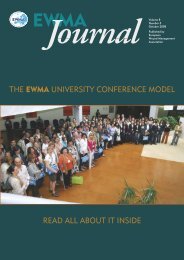best practice for the management of lymphoedema ... - EWMA
best practice for the management of lymphoedema ... - EWMA
best practice for the management of lymphoedema ... - EWMA
Create successful ePaper yourself
Turn your PDF publications into a flip-book with our unique Google optimized e-Paper software.
Compression garments<br />
C Correctly<br />
fitted compression garments<br />
should be prescribed appropriately <strong>for</strong><br />
patients with <strong>lymphoedema</strong>.<br />
The main use <strong>of</strong> compression garments is in<br />
<strong>the</strong> long-term <strong>management</strong> <strong>of</strong><br />
<strong>lymphoedema</strong>, usually following a period <strong>of</strong><br />
intensive <strong>the</strong>rapy. Compression garments<br />
are also used <strong>for</strong> prophylaxis or as part <strong>of</strong><br />
initial treatment. They may provide <strong>the</strong> only<br />
<strong>for</strong>m <strong>of</strong> compression used, or <strong>for</strong>m part <strong>of</strong> a<br />
regimen that includes o<strong>the</strong>r types <strong>of</strong><br />
compression. Some patients wear garments<br />
during waking hours only, <strong>for</strong> exercise only,<br />
or up to 24 hours per day.<br />
A wide variety <strong>of</strong> factors must be taken<br />
into account when determining whe<strong>the</strong>r a<br />
patient is suitable <strong>for</strong> compression<br />
garments 73 (Boxes 29 and 30).<br />
COMPRESSION GARMENT<br />
CONSTRUCTION<br />
Compression garments can be categorised<br />
according to method <strong>of</strong> fabric<br />
manufacture 74 :<br />
■ Circular knit garments – <strong>the</strong> material is<br />
continuously knitted on a cylinder and<br />
has no seam, and is used mainly to make<br />
ready to wear garments. Garments are<br />
shaped by varying stitch height and yarn<br />
tension (Figure 39). Circular knit<br />
garments may be thinner and more<br />
cosmetically acceptable than flat knit<br />
garments.<br />
■ Flat knit garments – <strong>the</strong> material is firmer<br />
and thicker than that <strong>of</strong> circular knit<br />
garments. Garments are knitted as a flat<br />
piece that is shaped by adding or<br />
removing needles (Figure 40). The flat<br />
piece is <strong>the</strong>n joined by a seam to <strong>for</strong>m <strong>the</strong><br />
garment. Most custom made garments<br />
are made from flat knit material.<br />
COMPRESSION GARMENT<br />
STANDARDS<br />
National standards <strong>for</strong> compression<br />
garments are usually prerequisites <strong>for</strong><br />
reimbursement and cover parameters such<br />
as testing methods, yarn specification,<br />
compression gradient and durability.<br />
Existing standards do not cover<br />
compression garments o<strong>the</strong>r than hosiery,<br />
eg <strong>the</strong>y do not cover arm sleeves, and<br />
differences in class pressure ranges and<br />
testing equipment make comparisons<br />
between standards difficult (Table 6) 74 .<br />
Fur<strong>the</strong>rmore, practitioners should be aware<br />
COMPRESSION<br />
GARMENTS<br />
BOX 29 Criteria indicating patient suitability <strong>for</strong> compression garments<br />
■ Good dexterity<br />
■ Intact, resilient skin<br />
■ No or minimal shape distortion<br />
■ Absent or minimal pitting oedema<br />
■ Swelling that can be contained by compression garments<br />
■ Concordant and motivated<br />
■ Ability to tolerate and manage hosiery (+/- carer support)<br />
■ Ability to monitor skin condition and engage in prevention strategies<br />
■ Symptom-based <strong>management</strong>/palliative needs<br />
BOX 30 Contraindications to compression garments<br />
■ Arterial insufficiency – ABPI 36mmHg >49mmHg<br />
BEST PRACTICE FOR THE MANAGEMENT OF LYMPHOEDEMA 39

















